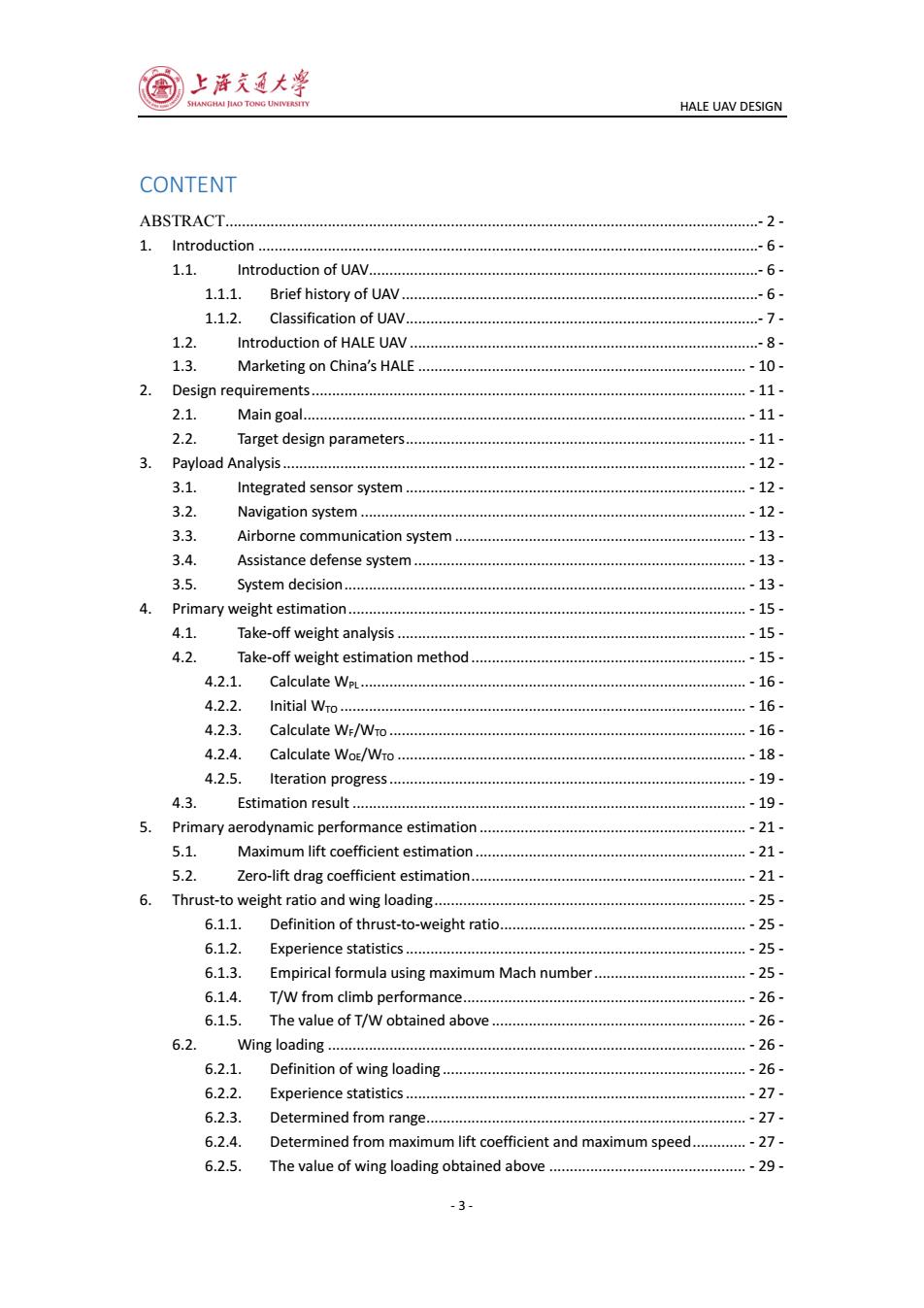正在加载图片...

国 上海文夏大学 SHANGHAI JIAO TONG UNIVERSITY HALE UAV DESIGN CONTENT ABSTRACT. -2- 1.Introduction.… -6- 1.1. Introduction of UAV.… -6- 1.1.1. Brief history of UAV........ 6- 1.1.2.Classification of UAV............... 7- 1.2. Introduction of HALE UAV. -8- 1.3. Marketing on China's HALE... -10- 2.Design requirements............ -11- 2.1. Main goal.… …-11- 2.2. Target design parameters............ -11- 3.Payload Analysis.… .-12- 3.1. Integrated sensor system -12- 3.2. Navigation system......... -12- 3.3. Airborne communication system-13- 3.4. Assistance defense system........................... -13- 3.5. System decision......... -13- 4. Primary weight estimation. -15- 4.1. Take-off weight analysis............. .-15- 4.2. Take-off weight estimation method .-15- 4.2.1. Calculate WPL.… .-16- 4.2.2. Initial Wro. .-16- 4.2.3. Calculate Wr/Wro.… …-16- 4.2.4. Calculate Wog/Wro..... -18- 4.2.5. Iteration progress.......... -19- 4.3. 5.Primary aerodynamic performance estimation...-21- 5.1. Maximum lift coefficient estimation.-21- 5.2. Zero-lift drag coefficient estimation.............. -21- 6. Thrust-to weight ratio and wing loading................. .-25- 6.1.1. Definition of thrust-to-weight ratio.......... .-25- 6.1.2. Experience statistics. .-25- 6.1.3. Empirical formula using maximum Mach number...........................-.25- 6.1.4. T/W from climb performance........... …-26- 6.1.5. The value of T/W obtained above26 6.2. Wing loading… .-26- 6.2.1. Definition of wing loading. -26- 6.2.2. Experience statistics. -27- 6.2.3. Determined from range... .-27- 6.2.4. Determined from maximum lift coefficient and maximum speed............-27- 6.2.5. The value of wing loading obtained above...-29- -3-HALE UAV DESIGN - 3 - CONTENT ABSTRACT..................................................................................................................................- 2 - 1. Introduction ..........................................................................................................................- 6 - 1.1. Introduction of UAV...............................................................................................- 6 - 1.1.1. Brief history of UAV.......................................................................................- 6 - 1.1.2. Classification of UAV......................................................................................- 7 - 1.2. Introduction of HALE UAV .....................................................................................- 8 - 1.3. Marketing on China’s HALE ................................................................................ - 10 - 2. Design requirements.......................................................................................................... - 11 - 2.1. Main goal............................................................................................................ - 11 - 2.2. Target design parameters................................................................................... - 11 - 3. Payload Analysis................................................................................................................. - 12 - 3.1. Integrated sensor system ................................................................................... - 12 - 3.2. Navigation system .............................................................................................. - 12 - 3.3. Airborne communication system ....................................................................... - 13 - 3.4. Assistance defense system................................................................................. - 13 - 3.5. System decision.................................................................................................. - 13 - 4. Primary weight estimation................................................................................................. - 15 - 4.1. Take-off weight analysis..................................................................................... - 15 - 4.2. Take-off weight estimation method................................................................... - 15 - 4.2.1. Calculate WPL .............................................................................................. - 16 - 4.2.2. Initial WTO ................................................................................................... - 16 - 4.2.3. Calculate WF/WTO ....................................................................................... - 16 - 4.2.4. Calculate WOE/WTO ..................................................................................... - 18 - 4.2.5. Iteration progress....................................................................................... - 19 - 4.3. Estimation result ................................................................................................ - 19 - 5. Primary aerodynamic performance estimation ................................................................. - 21 - 5.1. Maximum lift coefficient estimation.................................................................. - 21 - 5.2. Zero-lift drag coefficient estimation................................................................... - 21 - 6. Thrust-to weight ratio and wing loading............................................................................ - 25 - 6.1.1. Definition of thrust-to-weight ratio............................................................ - 25 - 6.1.2. Experience statistics................................................................................... - 25 - 6.1.3. Empirical formula using maximum Mach number..................................... - 25 - 6.1.4. T/W from climb performance..................................................................... - 26 - 6.1.5. The value of T/W obtained above .............................................................. - 26 - 6.2. Wing loading ...................................................................................................... - 26 - 6.2.1. Definition of wing loading .......................................................................... - 26 - 6.2.2. Experience statistics................................................................................... - 27 - 6.2.3. Determined from range.............................................................................. - 27 - 6.2.4. Determined from maximum lift coefficient and maximum speed............. - 27 - 6.2.5. The value of wing loading obtained above ................................................ - 29 -